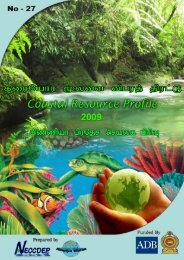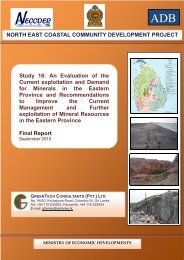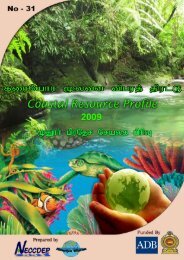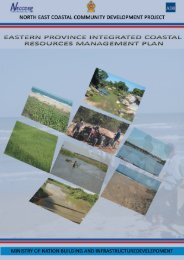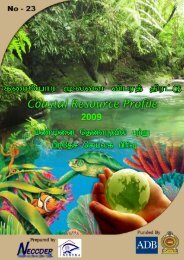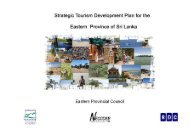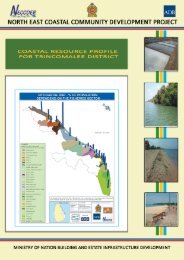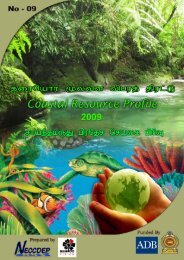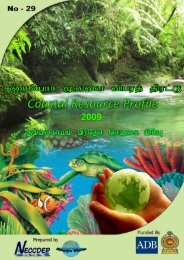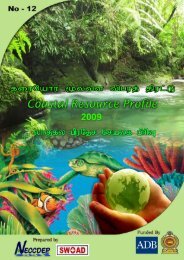Untitled - Neccdep.com
Untitled - Neccdep.com
Untitled - Neccdep.com
You also want an ePaper? Increase the reach of your titles
YUMPU automatically turns print PDFs into web optimized ePapers that Google loves.
TRINCOMALEE BAY SPECIAL MANAGEMENT AREA Page | 2<br />
population and urbanization in the coastal zone adds to this risk. The infrastructure<br />
necessary to avoid, minimize or mitigate these risks, so as to avoid negative impacts, is<br />
expensive and available resources are limited.<br />
9. Coastal fisheries also make a significant contribution to the national economy.<br />
Coastal habitats and their valuable physical and biological resources have increasingly <strong>com</strong>e<br />
under pressure as human activities have be<strong>com</strong>e more intense, and this has inevitably led to<br />
conflicts among resource users and threatened the livelihoods of all who depend on those<br />
resources. With these developments, there is the risk of exploiting coastal resources beyond<br />
sustainable limits (Ref. 1647, 1648) .<br />
10. The devastating tsunami of 26 th December 2004 created havoc particularly in the<br />
coastal regions of eastern and southern Sri Lanka. More than 35,000 inhabitants died whilst<br />
over 443,000 were displaced. The loss and damage to property was over 2 billion US $ (ADB<br />
feature on 8 December 2008). The destruction of infrastructure such as buildings and roads<br />
created a huge volume of building waste which was dumped along the coastline creating<br />
many secondary environmental issues. Large numbers of reconstruction projects were able<br />
to bring back and, indeed, upgrade, almost all the infrastructure facilities, thanks to donors<br />
and international <strong>com</strong>munities.<br />
11. The impacts of the tsunami on natural habitats such as mangroves, coral reefs, sea<br />
grass beds, and sand dunes were also locally significant. A number of restoration projects<br />
have been implemented to rehabilitate these natural systems.<br />
C. Economic importance of coastal region<br />
12. The coastal zone is a very important economic and environmental asset for the island<br />
nation of Sri Lanka. Five out of nine provinces of the country, the Western Province, the<br />
North-Western Province, the Southern Province, the Eastern Province and the Northern<br />
Province include the coastal zone. At present 59 % of the Sri Lankan population lives in<br />
coastal districts with maritime boundaries. Infrastructure facilities, employment opportunities,<br />
service facilities are required by this population and proper planning in the coastal region is<br />
the only way to meet these challenges.<br />
The 2007 study by Nayanananda (Ref.0907) of the economic significance of the coastal region of<br />
Sri Lanka, in the context of pre and post tsunami environmental changes, revealed valuable<br />
information on the economic importance of the coastal zone. The economic value of the<br />
coastal zone is immense because the coastal zone is rich in natural resources. The total<br />
national GDP value in 2006 was Rs. 980,720 million. Of this value, Rs. 426,998 million was<br />
contributed from the coastal provinces amounting to 44% of the total. In terms of contribution<br />
of coastal GDP by province, the Western Province contributed the highest which was about<br />
66% whilst the lowest contribution was about 4% from the Northern Province. The Eastern<br />
Province contribution was about 5.5%.<br />
13. Trade, tourism, manufacturing and transport, storage and <strong>com</strong>munication, fisheries<br />
and agriculture are the important economic activities in the coastal zone. Tourism has<br />
emerged as the fourth largest foreign exchange earner in Sri Lanka and coastal tourism is<br />
the major tourism <strong>com</strong>ponent.<br />
14. The information in Table I.1 below shows the contribution of the Eastern Province to<br />
national GDP and national coastal zone GDP. These data show the economic importance of<br />
the eastern coastal zone and highlight the need for proper management of resources to<br />
sustain socio-economic development.



